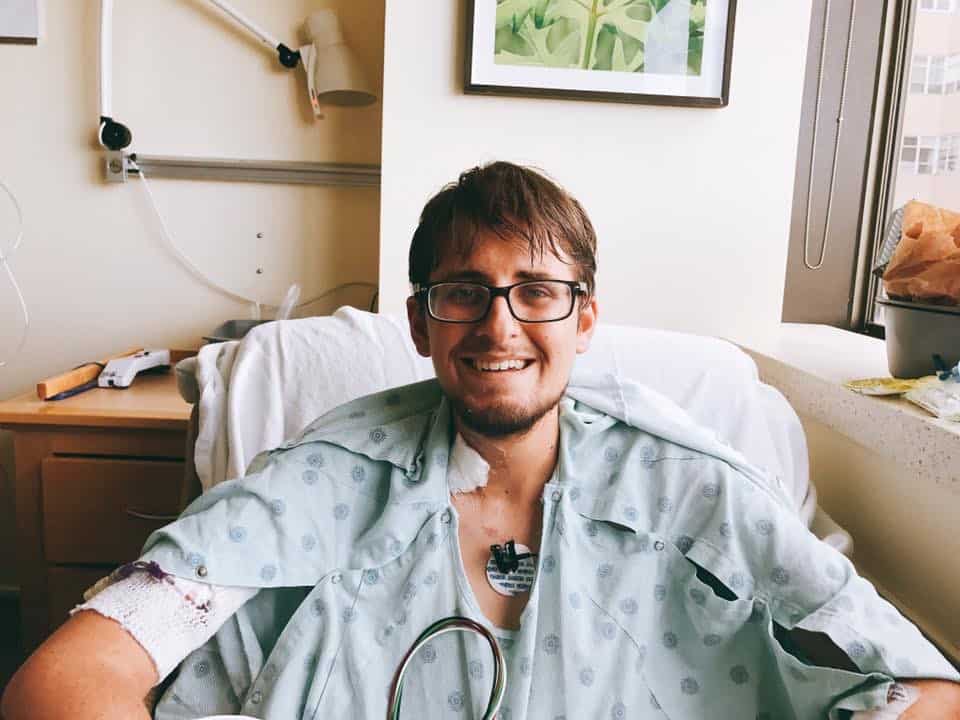Brad D. had profound hearing loss due to antibiotics he used to treat his cystic fibrosis. Being thrust into a world without sound, Brad longed to return to the hearing world he knew and loved. When he received bilateral Cochlear™ implants, he appreciated every sweet sound he heard from his father’s voice to music:
“A series of beeps pierced my 18-month silence. Then, ‘One, two, three, four …’
Those were the first words I heard. Counting up from the moment I left a silent world, a parallel dimension of four senses rather than five. I did not expect the first sounds to be numbers. I hate numbers; I am a writer rather than an engineer, unlike most of Silicon Valley where I live. I expected the first words heard to be something formal, like, ‘Welcome back to the hearing world.’ But, these numbers were poetic and sacred. I trembled and cried as my audiologist ran through days of the week, then through some month names.
My audiologist then asked how things sound. ‘Like a trippy cartoon,’ I said between tears. She sounded like Minnie Mouse. The rest of the environment resembled how a pinball machine sounds when you yank the crank and a cacophony of bells and whistles break the air. The first moments were as surreal as a Disneyland®1 ride and as fun too. No sound was mundane. As morphed as the sounds were, they were noise.
Thrust into hearing loss due to antibiotics
 I missed sound. Plenty of people love being deaf. That is great, but it is not for me. I stepped into the world of hearing loss when I lost hearing in my right ear at age 15. I was then involuntarily, completely thrusted into the deaf world at age 22 with the loss of my left ear’s hearing. Both periods of hearing loss were instigated by caustic antibiotics I used to treat cystic fibrosis, a genetic lung disease I was born with.
I missed sound. Plenty of people love being deaf. That is great, but it is not for me. I stepped into the world of hearing loss when I lost hearing in my right ear at age 15. I was then involuntarily, completely thrusted into the deaf world at age 22 with the loss of my left ear’s hearing. Both periods of hearing loss were instigated by caustic antibiotics I used to treat cystic fibrosis, a genetic lung disease I was born with.
I endured a double-lung transplant journey without hearing so much as a cough or IV pump alarm. I had my transplant about eight months before I received my cochlear implants. A transplant is terrifying enough when you can hear your loved ones and your favorite music. I could not have either comfort.
That day of implant activation in the audiology clinic, my tears had nearly dried when my dad, sitting next to me, finally spoke. Hearing his voice was … indescribable. It did not sound right, but it had the ‘aftertaste’ of his voice. It was recognizable. The voice I had heard long before I could form the word ‘Dada,’ the voice that imparted infinite wisdom to me throughout the years, the voice I had lost during my transplant journey when I needed it most.
A homecoming to the hearing world
My dad and I left the audiologist’s clinic with broad grins and leaps in our steps. On the drive from my clinic in San Francisco, to my home in San Jose, we listened to Johnny Cash, hoping that my high-pitched hearing would be evened out by his deep voice (it sort of worked).
It was my homecoming in the hearing world, and I was in ecstasy. It took effort to understand spoken words, but I could hold a conversation from hour one (that is not the case for everyone who gets cochlear implants). I enthusiastically plunged myself into the social life I had abandoned, and practiced my hearing in as many conversations as I could. I still sometimes miss words in conversation, but that is because of listening skills I lost while deaf, rather than my Cochlear implants’ limitations.
I have Cochlear implants for both ears, and I have the Kanso® Sound Processor and Nucleus® 7 Sound Processors2 (two of each). Some days, I want to be discrete and so I use my Kanso Sound Processor, which sits on my head without an earpiece. Other days, I let my processors show, so I wear my Nucleus 7 Sound Processor. I used to be self-conscious about having cochlear implants, but I have realized that most people think they look cool and futuristic. Don’t cochlear implants both look and function like something out of a science fiction film?
My favorite part about my sound processors
My favorite part about my Nucleus 7 Sound Processors is they allow me to seamlessly stream with Bluetooth®3 capabilities. (I can use Bluetooth with my Kanso Sound Processors, with the True Wireless™ Phone Clip.) With the Nucleus 7 Sound Processor, if Bluetooth is enabled on my phone, I simply press play on my app of choice and music streams (what feels like) directly into my brain. I could blast music in the middle of a meeting and no one would know it! My friends jokingly accuse me of secretly listening to music while they talk to me about something boring. OK, maybe I am.
I am fortunate to experience music, as it should be heard. All of the songs I have listened to sound exactly as I remember them. This has been the case since about three months after my cochlear implants were activated. (I am fortunate; not everyone hears music on-pitch like I do.)
It is not just music that is beautiful. Hearing birds chirping or the wind whooshing through trees has not gotten old for me, almost a year post-activation. The first time I heard rain, I sat on my porch and cried as many tears as there were raindrops in the sky. A couple of weeks ago, I saw my first live concert. It was not a band I particularly like, yet my heart soared as I absorbed the melodies.
Enjoying sounds and silence
Other times, I enjoy silence. If a baby screams or I need to focus or I have a headache, I am grateful for the ability to simply take my processors off and sit without a single distracting noise. It is the best of both worlds. When I was deaf without implants, I could not choose to hear or not hear. Now, it is a choice. I can even choose how loudly I hear something by adjusting volume on the processors. How cool is that?
Between choice of volume and the Bluetooth capabilities, I have found myself telling people I actually prefer hearing with cochlear implants rather than with my ears. My friends call me Cyborg and the Bionic Man. That is more than OK with me. I am proud to own tech that restores what I once thought to be forever lost.”
Are you struggling with your hearing loss due to antibiotics like Brad? Learn more about cochlear implants today.
- © Disney, All Rights Reserved
- The Cochlear Nucleus 7 Sound Processor is compatible with iPhone, iPad and iPod touch. For compatibility information, visit www.cochlear.com/compatibility.
- The Bluetooth® word mark and logos are registered trademarks owned by Bluetooth SIG, Inc. and any use of such marks by Cochlear is under license.
